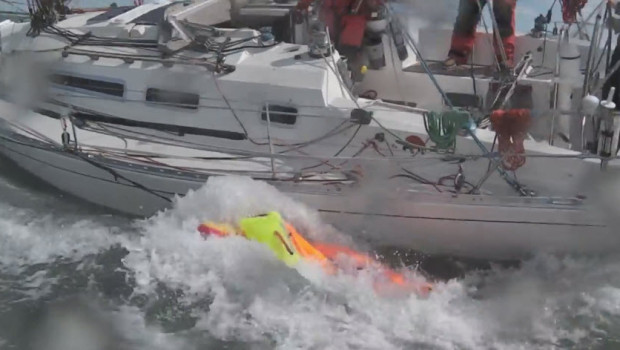When Your Life Depends on Others
Published on December 17th, 2015
If you’ve never fallen overboard, it is hard to imagine the helplessness of the moment. And even if you are tethered to the boat, your life remains in the hands of the crew, as Bruce Brown explains…
Tether usage is designed for two purposes: to help crews to stay on board a vessel, and to allow for a quick rescue if/when a Crew Over Board (COB) incident occurs by keeping the victim attached to the boat
In any case of COB, the mandate to stop the boat is always a critical step in rescue. Whatever it takes, stop the boat! Damage to sails or equipment becomes a secondary concern when a COB situation occurs (short of blowing a rig off the boat). Consider the USCG SAR mandate – save lives before property!
The elements of a recent Practical Boat Owner article show that any effort to tow a victim in the water are risky, or potentially fatal. In the COB symposiums done in San Francisco, we learned the danger of towing victims while they were in a Life Sling, and the difficulty anyone in the water has in holding on to a line when a vessel is moving (even as slow as 2 knots!)
Before anyone addresses safety harness design, tethers or attachments, the seamanship skill of stopping the boat when someone falls overboard is the critical element to prevent the drowning described in the accident report contained in the full article in Practical Boat Owner.
Few (if any) PFDs are designed to use when towing the person wearing the PFD. The hydrodynamics drive the victim underwater at less than 5 knots of speed, especially when an inherently buoyant PFD – Type III is worn. I am aware of testing done on the Switlik Fastnet Crew Vest (not USCG Approved) that showed it kept the wearers above the water when towed. It differs from current inflatable PFD designs in that it had twin inflatable bladders (and inflators).
Tether attachment location is an important element as well.
Using a rescue swimmer attachment (on the back of a harness) creates an attachment point that does not allow the wearer to disconnect himself/ herself from the vessel (in a sinking event like Pride of Baltimore). Wearing a safety harness/PFD that allows for a high attachment point on the chest is preferable under load to any other as damage to the back is probable if the harness is worn too low on the body.
Design for harness height to keep the attachment close to nipple height has been a standard suggestion for safety harness. Proper adjustment of a safety harness to fit snuggly to the body and is the best way to insure it will perform as it is designed.
The importance of COB drills and practice of basic boat handling skills are always an important element in crew preparation for any passage or race. Given the choice, I would rather be attached to the boat upon which I am sailing than in the inky dark blue sea hoping they can return to pick me up.









 We’ll keep your information safe.
We’ll keep your information safe.